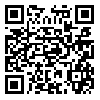Volume 31, Issue 4 (1-2023)
JGUMS 2023, 31(4): 300-311 |
Back to browse issues page
Negar Khosravifard * 

 1, Faegheh Gholinia2
1, Faegheh Gholinia2 

 , Farzaneh Ostovarrad3
, Farzaneh Ostovarrad3 

 , Zahra Dalili Kajan3
, Zahra Dalili Kajan3 

 , Hamideh Mohammadi4
, Hamideh Mohammadi4 

 , Parmida Farzam4
, Parmida Farzam4 




 1, Faegheh Gholinia2
1, Faegheh Gholinia2 

 , Farzaneh Ostovarrad3
, Farzaneh Ostovarrad3 

 , Zahra Dalili Kajan3
, Zahra Dalili Kajan3 

 , Hamideh Mohammadi4
, Hamideh Mohammadi4 

 , Parmida Farzam4
, Parmida Farzam4 


1- Department of Oral and Maxillofacial Radiology, Dental Sciences Research Center, Faculty of Dentistry, Guilan University of Medical Sciences, Rasht, Iran. , ngrkhosravi@yahoo.com
2- Department of Orthodontics, Dental Sciences Research Center, Faculty of Dentistry, Guilan University of Medical Sciences, Rasht, Iran.
3- Department of Oral and Maxillofacial Radiology, Dental Sciences Research Center, Faculty of Dentistry, Guilan University of Medical Sciences, Rasht, Iran.
4- Department of Oral and Maxillofacial Radiology, Faculty of Dentistry, Guilan University of Medical Sciences, Rasht, Iran.
2- Department of Orthodontics, Dental Sciences Research Center, Faculty of Dentistry, Guilan University of Medical Sciences, Rasht, Iran.
3- Department of Oral and Maxillofacial Radiology, Dental Sciences Research Center, Faculty of Dentistry, Guilan University of Medical Sciences, Rasht, Iran.
4- Department of Oral and Maxillofacial Radiology, Faculty of Dentistry, Guilan University of Medical Sciences, Rasht, Iran.
Abstract: (605 Views)
Background Dental abnormalities are considered important, since they cause aesthetic and functional problems for people. Orthodontic treatment becomes more complicated when craniofacial abnormalities are accompanied with dental abnormalities.
Objective This study aims to compare the frequency and type of dental abnormalities among patients with different skeletal malocclusion classes in northern Iran in terms of age and gender.
Methods Participants were 310 patients (32.9% Class I, 33.9% Class II, and 33.2% Class III). They were evaluated with respect to hypodontia, hyperdontia, impaction, microdontia, macrodontia, and dens invaginatus/evaginatus. Association of the prevalence of dental abnormalities with the type of malocclusion and gender was assessed by chi-square test and Fisher’s exact test, while independent t-test was used to determine its association with age.
Results The overall frequency of dental abnormalities was 33%. Class III patients had the highest rate of dental abnormalities (40.8%); however, the difference was not statistically significant (P=0.105). Hypodontia and impacted teeth were the most frequent abnormalities in all malocclusion groups. Occurrence of tooth impaction differed significantly among the three malocclusion groups (P<0.001), where the highest rate belonged to the class III group. Hypodontia was more frequent in males (P=0.040). Tooth impaction and microdontia were the two abnormalities that showed significant association with age (P<0.05).
Conclusion Dental abnormalities in northern Iran is more prevalent among people with the skeletal class III malocclusion. The prevalence of some dental abnormalities is associated with gender and age.
Objective This study aims to compare the frequency and type of dental abnormalities among patients with different skeletal malocclusion classes in northern Iran in terms of age and gender.
Methods Participants were 310 patients (32.9% Class I, 33.9% Class II, and 33.2% Class III). They were evaluated with respect to hypodontia, hyperdontia, impaction, microdontia, macrodontia, and dens invaginatus/evaginatus. Association of the prevalence of dental abnormalities with the type of malocclusion and gender was assessed by chi-square test and Fisher’s exact test, while independent t-test was used to determine its association with age.
Results The overall frequency of dental abnormalities was 33%. Class III patients had the highest rate of dental abnormalities (40.8%); however, the difference was not statistically significant (P=0.105). Hypodontia and impacted teeth were the most frequent abnormalities in all malocclusion groups. Occurrence of tooth impaction differed significantly among the three malocclusion groups (P<0.001), where the highest rate belonged to the class III group. Hypodontia was more frequent in males (P=0.040). Tooth impaction and microdontia were the two abnormalities that showed significant association with age (P<0.05).
Conclusion Dental abnormalities in northern Iran is more prevalent among people with the skeletal class III malocclusion. The prevalence of some dental abnormalities is associated with gender and age.
Review Paper: Applicable |
Subject:
Special
Received: 2022/02/23 | Accepted: 2022/08/23 | Published: 2022/11/16
Received: 2022/02/23 | Accepted: 2022/08/23 | Published: 2022/11/16
| Rights and permissions | |
 | This work is licensed under a Creative Commons Attribution-NonCommercial 4.0 International License. |


